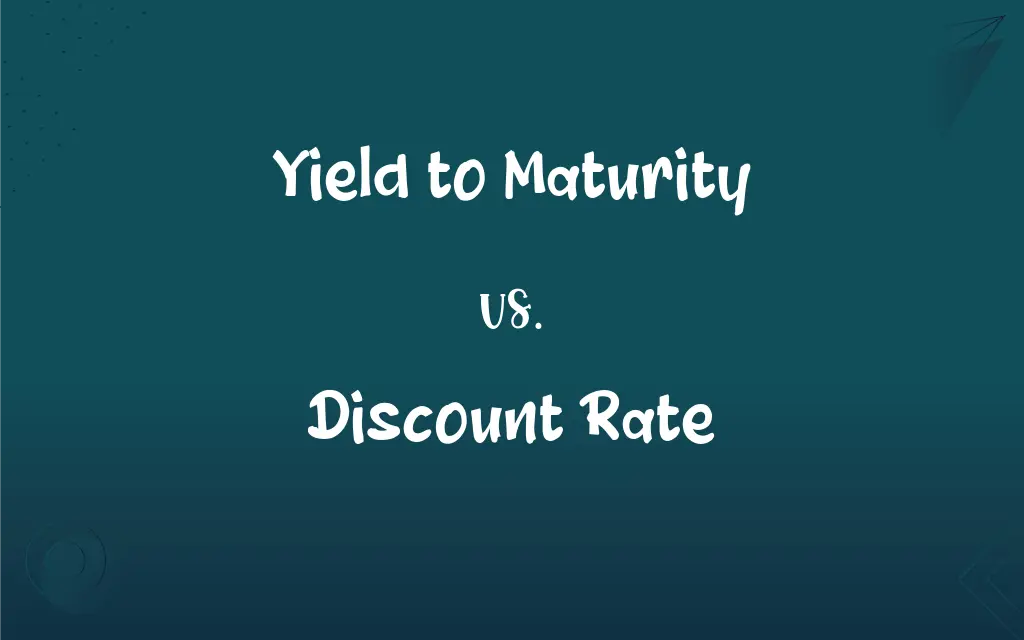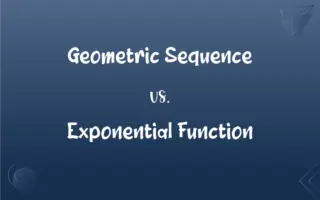Yield to Maturity vs. Discount Rate: What's the Difference?
Edited by Harlon Moss || By Janet White || Published on December 11, 2023
Yield to maturity (YTM) is the total return anticipated on a bond if held until it matures, while the discount rate is the interest rate used to determine the present value of future cash flows.

Key Differences
Yield to maturity (YTM) represents the annualized rate of return on a bond, assuming it is held to maturity and all payments are made as scheduled. The discount rate, on the other hand, is used in discounted cash flow (DCF) analysis to calculate the present value of future cash flows, such as dividends, earnings, or debt obligations.
YTM takes into account the current market price, par value, coupon interest rate, and time to maturity of the bond. The discount rate, often set by central banks, influences borrowing costs and is a key tool in monetary policy, affecting overall economic activity.
YTM provides investors with an estimate of the bond's potential return, giving a comprehensive picture of its value over time. The discount rate is used by businesses and investors to discount future cash flows to their present value, making it crucial for investment appraisals and business valuations.
YTM is specific to bonds and fixed-income securities, while the discount rate has a broader application across various financial calculations, including net present value (NPV) and internal rate of return (IRR) analyses.
The YTM calculation assumes that all coupon payments are reinvested at the same rate, which may not always be realistic. In contrast, the discount rate is often influenced by external economic factors and can vary based on the risk profile of the investment or cash flows being discounted.
ADVERTISEMENT
Comparison Chart
Definition
Total return expected on a bond if held to maturity
Interest rate used to calculate present value of future cash flows
Primary Use
Evaluating bond investments
Discounting cash flows in various financial analyses
Influence Factors
Market price, par value, coupon rate, time to maturity
Central bank policies, market conditions, risk assessment
Application Scope
Specific to bonds and fixed-income securities
Broad application in finance, including NPV and IRR calculations
Assumptions
Assumes reinvestment of coupons at same rate
Varies based on economic conditions and investment risks
ADVERTISEMENT
Yield to Maturity and Discount Rate Definitions
Yield to Maturity
Reflects the comprehensive return of a bond over its remaining life.
Investors use YTM to compare the long-term value of different bonds.
Discount Rate
Influenced by monetary policies and market conditions.
The central bank's hike in the discount rate affected our investment strategy.
Yield to Maturity
Annualized total return expected on a bond if held until maturity.
The bond's yield to maturity was higher than its coupon rate, making it an attractive investment.
Discount Rate
Interest rate used to discount future cash flows to present value.
We used a 5% discount rate to calculate the project's net present value.
Yield to Maturity
YTM includes interest payments and capital gains or losses.
The bond's YTM accounts for the difference between its purchase price and par value.
Discount Rate
Crucial for determining the value of future earnings or obligations.
The discount rate helped us assess the current worth of our future revenue streams.
Yield to Maturity
YTM is affected by the bond's current market price.
A decline in market price increased the bond's yield to maturity.
Discount Rate
Varies based on the risk profile of the investment.
Higher-risk projects often have a higher discount rate.
Yield to Maturity
YTM calculation assumes reinvestment of coupon payments.
The bond's yield to maturity assumes that I reinvest each coupon payment at the same rate.
Discount Rate
Used in various financial calculations like NPV and IRR.
The discount rate was key in our internal rate of return analysis for the new venture.
FAQs
What factors influence the discount rate?
The discount rate is influenced by central bank policies, market conditions, and the risk profile of the investment.
How is YTM calculated?
YTM is calculated based on the bond's current market price, par value, coupon rate, and time to maturity.
Where is the discount rate applied?
The discount rate is applied in various financial analyses, including NPV and IRR calculations.
Does YTM assume reinvestment of coupon payments?
Yes, YTM assumes that all coupon payments are reinvested at the same rate.
What does the discount rate represent?
The discount rate is the interest rate used to determine the present value of future cash flows.
Is YTM specific to bonds?
Yes, YTM is specifically used for evaluating bonds and fixed-income securities.
What is a good YTM for a bond?
A good YTM varies based on market conditions, but it should ideally be higher than the inflation rate and reflect the bond's risk.
What is yield to maturity (YTM)?
YTM is the total expected return on a bond if held until its maturity date.
Can the discount rate change over time?
Yes, the discount rate can change based on economic conditions and monetary policies.
How does market price impact YTM?
If a bond's market price is below par, YTM will be higher than the coupon rate, and vice versa.
Why is the discount rate important in investment decisions?
The discount rate helps determine the present value of future cash flows, crucial for investment appraisals and valuations.
What is the relationship between YTM and bond maturity?
YTM considers the time remaining until the bond's maturity, with longer maturities typically involving more risk and potentially higher returns.
Why might businesses use different discount rates?
Businesses use different discount rates for various projects based on the associated risks and expected returns.
Is the discount rate the same as the interest rate?
The discount rate is a type of interest rate, but it's specifically used for discounting future cash flows to present value.
What role does the discount rate play in DCF analysis?
In DCF analysis, the discount rate is used to convert future cash flows into their present value.
Can YTM be negative?
Yes, YTM can be negative in a low-interest-rate environment when bond prices are high relative to their returns.
Do central banks set the discount rate?
Central banks influence the discount rate, particularly in the context of monetary policy.
How does inflation impact the discount rate?
Higher inflation often leads to a higher discount rate, as it decreases the present value of future cash flows.
Is YTM fixed for the life of the bond?
No, YTM varies with changes in the bond's market price and interest rates.
Does YTM affect a bond's price?
YTM is affected by the bond's market price; as the price changes, YTM changes inversely.
About Author
Written by
Janet WhiteJanet White has been an esteemed writer and blogger for Difference Wiki. Holding a Master's degree in Science and Medical Journalism from the prestigious Boston University, she has consistently demonstrated her expertise and passion for her field. When she's not immersed in her work, Janet relishes her time exercising, delving into a good book, and cherishing moments with friends and family.
Edited by
Harlon MossHarlon is a seasoned quality moderator and accomplished content writer for Difference Wiki. An alumnus of the prestigious University of California, he earned his degree in Computer Science. Leveraging his academic background, Harlon brings a meticulous and informed perspective to his work, ensuring content accuracy and excellence.































































